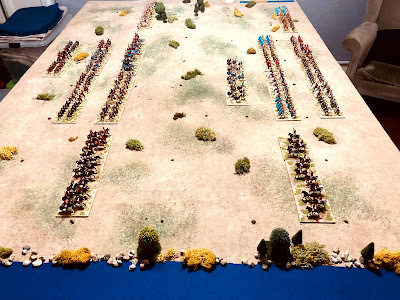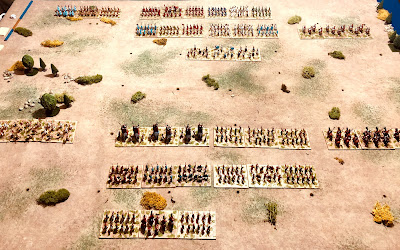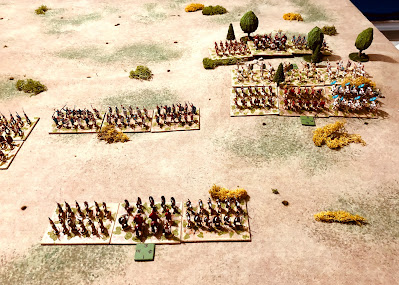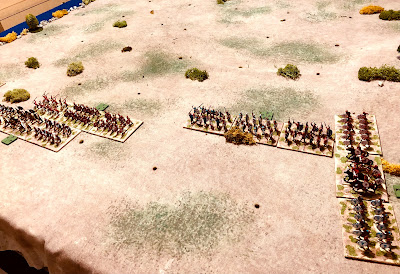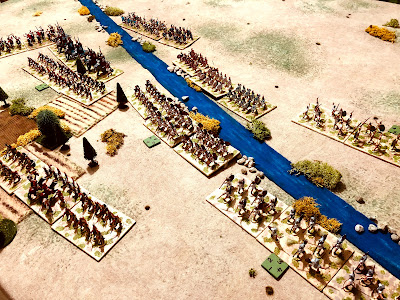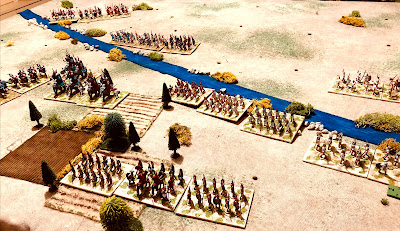I thought I would be fun to have a quick Punic War ancients game as a quick reminder of the rules using One Hour Wargames (OHW) scenario 21 (twin objectives). I opted to use six units per side as per the scenario but selected the units myself rather than have them generated. This is so I could use a unit of elephants.
OHW scenarios are normally for a tabletop size of 3 by 3 foot, and I would normally have slightly increased the size and played the game on a 4 by 4 foot tabletop. However, I though it would be interesting to try and stretch the scenario to fit a 6 by 4 foot tabletop. While at the same time increasing unit base sizes from the OHW suggested 4-6 inch width to a width of 12 inches.
The rules remained the same when it came to movement with 6, 9 ad 12 inches for heavy infantry, light infantry, and cavalry.
Order of battle...
Romans:
- 1 x Light infantry
- 3 x Heavy infantry
Carthaginians:
- 1 x Light infantry
- 1 x Elephants
- 1 x Light cavalry
- 3 x Heavy infantry
In terms of rules for elephants and light cavalry as OHW does not have specific rules for them:
Light Cavalry - operate like light infantry (Skirmishers) moving 12 inches and are allowed to exit combat with enemy foot units. They cannot pass through through other friendly units unlike light infantry.
Elephants - move 9 inches, hits equal a D6 with no reductions for armour. When eliminated roll D6:
- 1-2 they go berserk and attack nearest friendly unit within 9 inches and are then removed from play.
- 3-4 they are removed from play immediately.
- 5-6 they go berserk and attack nearest enemy unit within 9 inches and are then removed from play.
Generals - I also had one general in each army assigned to a heavy infantry unit. These represented the veteran part of the army. Units with an assigned general were able to re-roll they hit D6, but had to accept the second value.
 |
| Opening moves of the game with Roman forces defending the town and wooded hill and Carthaginian forces having to wheel around to engage. |
My figures are based on 4 by 3 inch bases. I used three of them to make a unit with a 12 inch width. This made for some largish looking units and also helped with the tracking of hits. For each 5 hits one based was removed.
 |
| Carthaginians split their attack while the elephants engage the Roman centre. |
 |
The town defenders are drawn out to support the defence against the elephants. The Carthaginian light cavalry were now unable to join any attack and waited in reserve for an opportunity.
|
 |
The Roman centre collapses and the remnants are able to escape and hold up in the town. Time is now against the Carthaginians who need to control one of the town or hill objectives to salvage the game and get a draw.
|
 |
| Romans did enough in the end to win by holding the town and denying control of the hill. One more turn and the Carthaginians would have controlled the hill and gained a draw. |
I enjoyed playing the scenario and using the larger unit sizes. As for the reasons I liked the larger units, they are:
- They are visually more appealing and I get to see more of the figures I have spent time and effort painting, which is always a good thing.
- The ability to manoeuvre units is restricted as they can easily get the way of each other. I definitely started to think more in terms of my army's centre and flanks, and what was in my first line and second line for support.
- The benefits of a front line of light infantry who can pass through the lines behind heavy infantry became a lot more apparent to me. The larger units stopped light infantry from moving sideways out of any trouble.
- The constraints of movement places more importance on how an army is deployed. As any deployment mistakes are not easily undone with some quick manoeuvres before engaging the enemy.
Further thoughts:
- I am really tempted to increase the size of units for my Punic War campaign and reduce to number of units to 6-8 rather than the intended 10-12 units.
- Rather than removing one base from a unit for every 5 hits, have one base removed after 7 hits. A unit would then be eliminated upon taking 14 hits (one less than OHW's 15 hits for elimination). That way units will always have a minimum of 2 bases.
- Having read Lost Battles by P. Sabin I definitely want to see what deployment rules can be added.
As for my Punic War campaign, the opening campaign moves are to be made this weekend.


























